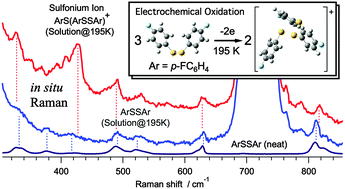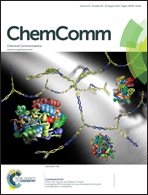Low temperature in situ Raman spectroscopy of an electro-generated arylbis(arylthio)sulfonium ion†
Abstract
A low temperature in situ Raman spectroscopic method was developed for the detection of unstable intermediates in electro-organic chemistry. It was effective for monitoring the generation of ArS(ArSSAr)+ by the electrochemical oxidation of ArSSAr (Ar = p-FC6H4) in Bu4NBF4/CH2Cl2 at 195 K. The intensity of a Raman band at 427 cm−1, which is attributable to the S–S vibration of ArS(ArSSAr)+, increased with an increase in the electricity until 2/3 F of the electricity was consumed, whereas decreased with a further increase in the electricity indicating the decomposition of ArS(ArSSAr)+.


 Please wait while we load your content...
Please wait while we load your content...